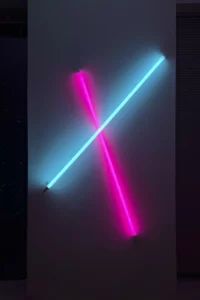Do you have doubts whether fluorescent lights (including CFLs) or LEDs are the superior options?
Lighting options for commercial spaces such as offices, retail spaces, and factories are diverse to become overwhelming. Because lighting profoundly impacts people’s perceptions of risk, productivity, comfort, and satisfaction in a retail setting, there must be options for everyone.
LED vs fluorescent lighting are now the two most popular choices for commercial lighting. LED tube lights are a recent lighting choice, but they have quickly surpassed incandescent bulbs and fluorescent lamps to become the industry standard.
So, first, we’ll go into detail about each one individually, and then we’ll make a side-by-side comparison of the two technologies that is– LED vs fluorescent.
What is a Fluorescent Tube light?
As fluorescent light lamps are more energy-efficient and last significantly longer than incandescent bulbs, they have mostly replaced incandescent lights in many common settings.
The inside of a fluorescent lamp is coated with a fluorescent material, which converts the lamp’s ultraviolet radiation into visible light. For a fluorescent light to start glowing, either a voltage pulse or a third electrode (an additional metal portion) must be applied to the inside of the bulb.
The light’s voltage needs also increase as it warms up. Ballasts in fluorescent lights maintain proper voltage levels (a magnetic device in older bulbs and an electrical one in newer fluorescent technology). Fluorescent lights require more and more power to generate the same amount of light as they age, which continues until the voltage surpasses the ballast’s constant resistance and the light goes off (fails). Over time, the efficacy of fluorescent lighting decreases because more and more power is required to maintain the same lumen output.
Simply Put, What is an LED (or Light-Emitting Diode)?
The acronym LED refers to the light-emitting diode. It is common for electricity to flow in just one way through a diode, an electrical component with two electrodes (an anode and a cathode) (in through the anode and out through the cathode). Semi-conductive materials, like silicon or selenium, are typically used to construct diodes because of their ability to conduct electricity in some but not all settings (e.g., at certain voltages, current levels, or light intensities).
This gadget, made from semiconductors, emits light when electricity is sent through it—a photovoltaic cell’s polar opposite (a device that converts the visible light into electrical current).
When Compared, How Do Fluorescent Tube Light Vs. LED Tube Light Differ?
These technologies represent fundamentally distinct approaches to generating visible light; LED tube lights are a solid-state technology. Within the fluorescent tube light is a phosphor coating that absorbs the UV radiation produced and converts it into visible light. LED tube light are energy efficient because they only produce electromagnetic radiation in the visible light spectrum and don’t generate any heat or other forms of electromagnetic radiation that can be seen by the human eye (such as UV). An infrared emitting diode, or IRED, is a type of LED developed to radiate heat in the infrared spectrum.
How come LEDs won’t make Fluorescent Bulbs Obsolete?
LED tube light efficiency has overtaken fluorescent lights in recent years, improving much faster. Further, fluorescent lights require the employment of ballast to stabilize the internal current that produces light. The lamp will buzz if the ballast has even the tiniest flaw or has been destroyed. Other flaws include:
- Because of their elongated design, fluorescent tube light can be difficult to retrofit.
- Since fluorescent tube lights contain mercury, they might cause complications when it comes time to dispose of old bulbs.
- Fluorescent tube light shines light in every direction simultaneously. It should be no surprise that much of this illumination is lost (for example, that portion directed at the ceiling).
Fluorescent Tube Lighting vs. Light Emitting Diode (LED) Comparison
- Because of how quickly they turn on and off, LED tube lights are perfect for controlling manually (there is no warm-up or cool-down period). They provide consistent illumination with no flicker. In contrast, there’s a brief lag before fluorescent lights come on. However, modern, faster-starting fluorescent lights have eliminated the lengthy warm-up time required by older kinds. Starters, transformers, and ballast faults are the most common causes of start-up delays or failures. As a fluorescent light bulb nears the end of its life, it may flicker, emit a whirling or pinkish glow, shine exclusively at its extreme ends, or repeatedly turn on and off.
- LED tube light can come in a variety of color temperatures, most commonly from 2200K to 6000K, which are often correlated with one another (ranging from yellow to light blue), while adjusting the amount of phosphor within the bulb allows for a wide range of CCT values to be achieved with fluorescent lighting. Depending on the circumstance, the typical values can range from a warm white 2700K to a daylight 6500K.
- An LED light source’s Color Rendering Index (CRI) varies greatly from one bulb to the next. However, a wide range of CRI values is available, often between 65 and 95. while fluorescent lights typically have a CRI between 62 and 80. This is a fairly nice color rendering, yet it leaves room for improvement compared to LED.
- You can adjust the light output of dimmable LED tube light from full brightness to a mere fraction of a lumen. Dimming an LED can reduce the forward current or alter the pulse duration.
- While earlier fluorescent tube lights aren’t usually dimmable, newer ones can be efficiently muted (down to around 15% of their regular light), whereas to lower the brightness of fluorescent light successfully, you must use a ballast designed for that purpose.
When comparing LED vs. fluorescent tubes there is only ever going to be one victor: LEDs. They save you money since they last longer and consume less energy. More easily recyclable, they have a lower environmental impact.
Do They Make Recycling Difficult?
- LED lights are much simpler to recycle than their fluorescent lamp cousins.
- Toxic chemicals are commonly found in fluorescent bulbs. Mercury is just one example of a substance that could be dangerous to humans. During a break, they are extremely fragile and cannot be reused.
- Due to the presence of hazardous materials, they must be handled by a hazardous waste disposal unit.
- Due to the increased longevity of LED tube lights, fewer of them will need to be replaced or discarded over time. You can recycle them at municipal centers once they stop working. Some companies will come to pick up your old lights to recycle them.
- LED tube light use fewer potentially harmful substances. You can reuse the electronic parts and recycle the aluminum.
- Strong plastic is used in LED lights. This is significantly less likely to break, making it a safer option. You can also recycle the plastic.
Conclusion
Furthermore, many modern LED tube lighting systems include extras that older fluorescent light bulbs do not.
By illustration, the Wi-Fi connectivity of modern LED lighting systems enables administrators to set lighting schedules automatically that turn the lights on and off at certain intervals. Even better, you can set your lights to change color or temperature automatically throughout the day or week based on the weather or other environmental factors using a centralized app or program. Add motion detectors to your “smart lighting” system to turn on the lights only when they detect motion.
Although the initial investment in an LED lighting system for business areas may be higher, the long-term benefits and cost savings of such an upgrade make up for the initial outlay.
Related Posts
January 3, 2023
Bachelorette Party Decorations
Bachelorette parties have grown from small gatherings for a new bride to big events that a bride’s friends plan to celebrate her final days as a…
March 30, 2022
Create A Romantic Atmosphere With LED Love Neon Sign
Proper lighting is required to create a romantic atmosphere in a place. You have to use the best lighting for decorating a space for Valentine's day,…
November 22, 2021
Customisable LED Neon Signs – create a sign as unique as you!
Customisable Neon Led Lights, with their vibrant colours and mesmerising hues, are an essential part of any modern-day business. Neon lights create a…








